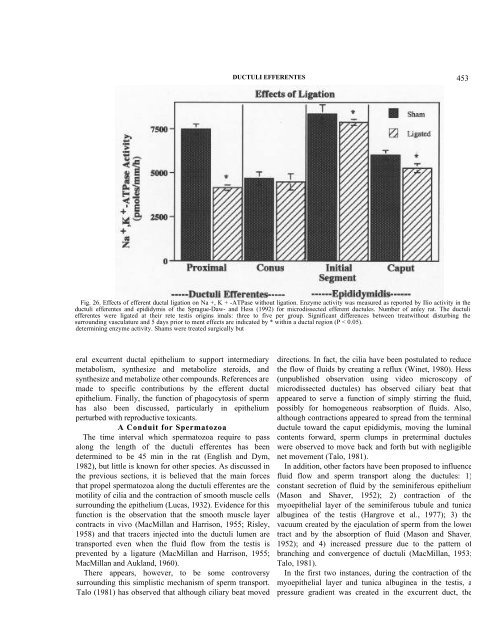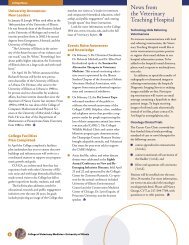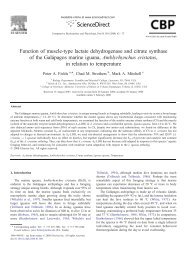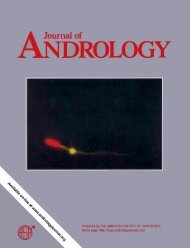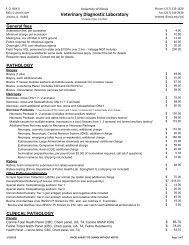Structure and Function of the Ductuli Efferentes - University of Illinois ...
Structure and Function of the Ductuli Efferentes - University of Illinois ...
Structure and Function of the Ductuli Efferentes - University of Illinois ...
Create successful ePaper yourself
Turn your PDF publications into a flip-book with our unique Google optimized e-Paper software.
DUCTULI EFFERENTES453Fig. 26. Effects <strong>of</strong> efferent ductal ligation on Na +, K + -ATPase without ligation. Enzyme activity was measured as reported by Ilio activity in <strong>the</strong>ductuli efferentes <strong>and</strong> epididymis <strong>of</strong> <strong>the</strong> Sprague-Daw- <strong>and</strong> Hess (1992) for microdissected efferent ductules. Number <strong>of</strong> anley rat. The ductuliefferentes were ligated at <strong>the</strong>ir rete testis origins imals: three to five per group. Significant differences between treatwithout disturbing <strong>the</strong>surrounding vasculature <strong>and</strong> 5 days prior to ment effects are indicated by * within a ductal region (P < 0.05).determining enzyme activity. Shams were treated surgically buteral excurrent ductal epi<strong>the</strong>lium to support intermediarymetabolism, syn<strong>the</strong>size <strong>and</strong> metabolize steroids, <strong>and</strong>syn<strong>the</strong>size <strong>and</strong> metabolize o<strong>the</strong>r compounds. References aremade to specific contributions by <strong>the</strong> efferent ductalepi<strong>the</strong>lium. Finally, <strong>the</strong> function <strong>of</strong> phagocytosis <strong>of</strong> spermhas also been discussed, particularly in epi<strong>the</strong>liumperturbed with reproductive toxicants.A Conduit for SpermatozoaThe time interval which spermatozoa require to passalong <strong>the</strong> length <strong>of</strong> <strong>the</strong> ductuli efferentes has beendetermined to be 45 min in <strong>the</strong> rat (English <strong>and</strong> Dym,1982), but little is known for o<strong>the</strong>r species. As discussed in<strong>the</strong> previous sections, it is believed that <strong>the</strong> main forcesthat propel spermatozoa along <strong>the</strong> ductuli efferentes are <strong>the</strong>motility <strong>of</strong> cilia <strong>and</strong> <strong>the</strong> contraction <strong>of</strong> smooth muscle cellssurrounding <strong>the</strong> epi<strong>the</strong>lium (Lucas, 1932). Evidence for thisfunction is <strong>the</strong> observation that <strong>the</strong> smooth muscle layercontracts in vivo (MacMillan <strong>and</strong> Harrison, 1955; Risley,1958) <strong>and</strong> that tracers injected into <strong>the</strong> ductuli lumen aretransported even when <strong>the</strong> fluid flow from <strong>the</strong> testis isprevented by a ligature (MacMillan <strong>and</strong> Harrison, 1955;MacMillan <strong>and</strong> Aukl<strong>and</strong>, 1960).There appears, however, to be some controversysurrounding this simplistic mechanism <strong>of</strong> sperm transport.Talo (1981) has observed that although ciliary beat moveddirections. In fact, <strong>the</strong> cilia have been postulated to reduce<strong>the</strong> flow <strong>of</strong> fluids by creating a reflux (Winet, 1980). Hess(unpublished observation using video microscopy <strong>of</strong>microdissected ductules) has observed ciliary beat thatappeared to serve a function <strong>of</strong> simply stirring <strong>the</strong> fluid,possibly for homogeneous reabsorption <strong>of</strong> fluids. Also,although contractions appeared to spread from <strong>the</strong> terminalductule toward <strong>the</strong> caput epididymis, moving <strong>the</strong> luminalcontents forward, sperm clumps in preterminal ductuleswere observed to move back <strong>and</strong> forth but with negligiblenet movement (Talo, 1981).In addition, o<strong>the</strong>r factors have been proposed to influencefluid flow <strong>and</strong> sperm transport along <strong>the</strong> ductules: 1)constant secretion <strong>of</strong> fluid by <strong>the</strong> seminiferous epi<strong>the</strong>lium(Mason <strong>and</strong> Shaver, 1952); 2) contraction <strong>of</strong> <strong>the</strong>myoepi<strong>the</strong>lial layer <strong>of</strong> <strong>the</strong> seminiferous tubule <strong>and</strong> tunicaalbuginea <strong>of</strong> <strong>the</strong> testis (Hargrove et al., 1977); 3) <strong>the</strong>vacuum created by <strong>the</strong> ejaculation <strong>of</strong> sperm from <strong>the</strong> lowertract <strong>and</strong> by <strong>the</strong> absorption <strong>of</strong> fluid (Mason <strong>and</strong> Shaver,1952); <strong>and</strong> 4) increased pressure due to <strong>the</strong> pattern <strong>of</strong>branching <strong>and</strong> convergence <strong>of</strong> ductuli (MacMillan, 1953;Talo, 1981).In <strong>the</strong> first two instances, during <strong>the</strong> contraction <strong>of</strong> <strong>the</strong>myoepi<strong>the</strong>lial layer <strong>and</strong> tunica albuginea in <strong>the</strong> testis, apressure gradient was created in <strong>the</strong> excurrent duct, <strong>the</strong>


